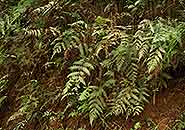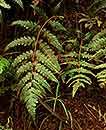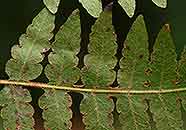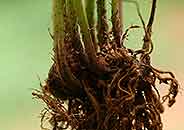Blotiella glabra (Bory) R.M. Tryon
Synonyms |
Lonchitis glabra Bory |
|---|---|
Common name |
|
Description |
Rhizome widely creeping, up to 2.5 cm wide, ending in a suberect, somewhat enlarged aerial portion; rhizome hairs dense, shiny brown, up to 15(-40) mm long. Fronds tufted or closely spaced, (0.9-)2-3 m tall. Stipe up to 0.8 m, pale brown, said to be green with purple stripes when fresh, thinly pubescent with short, brown hairs. Lamina 0.5-1.3(-2) m × 0.3-0.8 m, ovate-lanceolate to elliptic in outline, 2- to 3-pinnatifid, thinly pubescent on both surfaces, secondary rhachis winged. Pinnae oblong-ovate to lanceolate-acuminate, 40-45 cm x 13 cm, uniformly incised from the apex towards the base; pinnules lanceolate-oblong in outline, 10 cm x 2.5 cm; pinnules variously incised or pinnatifid into 10-12 pairs of rounded lobes, 10.5 cm x 0.8 cm, seperated by broad sinuses, hairy on both surfaces; venation plane or impressed above, conspicuously prominent beneath; rhachis densely hairy. Sori ± crescent-shaped, situated at the base of the sinuses between the pinnules, c. 4 mm long and also 1-3 smaller ones on each margin above sinuses; indusium present. |
Notes | Differs from B. natalensis by having a widely creeping rhizome and fronds that are up to 2m long. It also forms small colonies, allthough isolated plants are encountered. Tectaria gemmifera has laminal sori and buds or plantlets on the rhachis or costae. |
Derivation | glabra: hairless; reference not clear. |
Habitat | Near streams or in seepage zones in deep shaded evergreen forest, in giant heath zone, sometimes in bamboo. |
Distribution worldwide | Widespread on tropical African mountains, also in the Madagascan region. |
Distribution in Africa |
Burundi, Cameroon, Dem. Republic of Congo, Equatorial Guinea (incl. Bioko), Ethiopia, Gabon, Kenya, Malawi, Mozambique, Rwanda, South Africa, Swaziland, Tanzania , Uganda, Zambia, Zimbabwe. |
Growth form |
Terrestrial. |
Literature |
|



